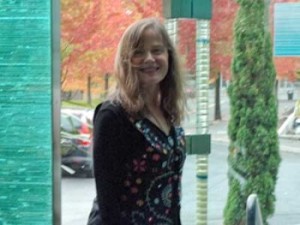Changing Momentum
Welcome to Creative Conversations—real-time discussions about the creative process. Today Janet and artist, Lisa Sheets will explore the next burning topic: Changing Momentum.
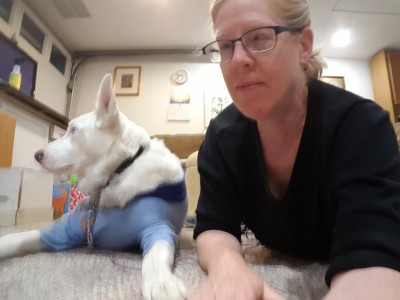 (Lisa and faithful dog Yuki)
(Lisa and faithful dog Yuki)
Hi, Lisa. I’ve got my small glass of wine on my desk, and a view of your beautiful new website with multiple pages, like gallery rooms, devoted to the many types of art you create. We’ve known each other for years, and you were actively sculpting and collage making, showing and doing public art when we met.
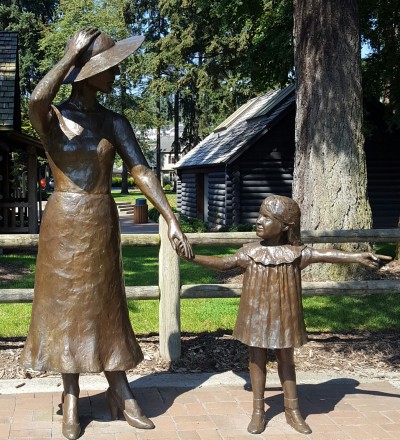
(Lisa Sheet’s sculpture @ Park in Redmond WA.)
Lisa: Hey Janet! I love that we both have our glass of wine nearby LOL.
Janet: So, Lisa. What do you mean by Changing Momentums?
Lisa: Well when I thought about the word “momentum” it occurred to me that when I was younger, I thought of momentum as one thing. Forward. Steady movement. But as I experience more life, I realize that it’s not just one steady even movement forward. Sometimes momentum stops, or moves backward, or sideways. Sometimes momentum is easy to push along, effortlessly progressing forward! Other times it feels like I need to expend all the energy I have just to stay in one place and not lose my footing. So that is the idea I was playing with when I suggested the title.
Janet: I know what you mean. On any creative venture, I like to see myself moving forward, but lots of times moving forward requires going back. I think I’ve finished a novel; then I need to tear it up again during a major revision process. It’s hard not to feel disheartened when I’m doing that, and it’s hard to remember this backward movement is going to get the story to a better place.
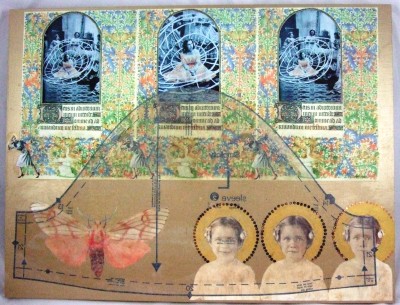
Lisa: Yes. For me, because I am often working on many pieces at the same time, I haven’t historically tracked my momentum in terms of how far along I am on any specific piece of art. If I have 10 pieces in some stage of done-ness for awhile, and I end up rethinking or changing completely . . . I’m ok with that. Because the group of pieces is still moving in a direction toward being resolved. I think maybe for writers it’s different? Because you might focus on just one or two MAJOR projects at a time?
Janet: I do know some writers who juggle multiple projects, I’m just not one of them. How do you manage to juggle so many balls?
Lisa: For me, it is common to have a bunch of different pieces in various stages all around the studio. So I think one aspect of momentum that has changed for me is my definition of how to track it. In the past, I tracked it by exterior accomplishments (achieved a specific award, got into a gallery I had my eye on, just showed my artwork in a new state where I’ve never exhibited before, that kind of thing. That focus on momentum outside my own creative process. But more focused on how others in my profession are noticing me or rewarding me, that is the part that took a major shift. Because no matter how good you are those external rewards and validations can change and shift over time. We can’t let our feeling of worthiness or success rest on that kind of definition of forward momentum! So I learned that in the past 15 years or so.

Janet: Yes, we get to the heart of the creative paradox, so many of us deal with. The joy of simply doing our art, making things we’ve dreamed of, versus the reaction of others, telling us if our art is worthwhile. Sometimes we have a lot going on in the world. In my case, books coming out, in your gallery exhibits or public sculptures. But most of the time we work in our studios, just being with our works-in-progress. We need to know the work has its own worth.
Lisa: I also spend a lot of time interacting with other artists or paying attention to what other artists are doing. Not only is it good creative fuel, but I find that social/personal support from interacting with other artists really important: I’m not alone, I’m not isolated. I’m not the only one going through these challenges or feeling these feelings. And we all are on the path with different timings of achieving success, being able to provide encouragement to others. And at other times needing advice or others on that momentum path to urge us to persevere and remind us it isn’t always a steady uphill climb.
I have an artist mentor who is in his 70s who has really given me support recently around the idea that everything does ebb and flow. And to not be surprised when shifts happen or getting slowed down or stuck occurs. Not to mention the influence of the rest of the world, the economy, and changing trends in the market.
Janet: I love being reminded that we are not alone.
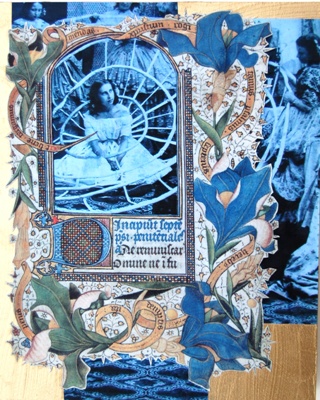
What inspires you to do to this kind of collage work?
Lisa: Hmmm . . . Well, what materials I work in have changed over time. When I was young and in
college, I worked with a lot of process laden materials like printmaking and cast metal sculpture. Once I graduated and no longer had access to the equipment as easily as I did in school, I did start exploring different media. Also what I wanted to talk about changed. With sculptures, I was doing mostly standing figure nudes of the female form.
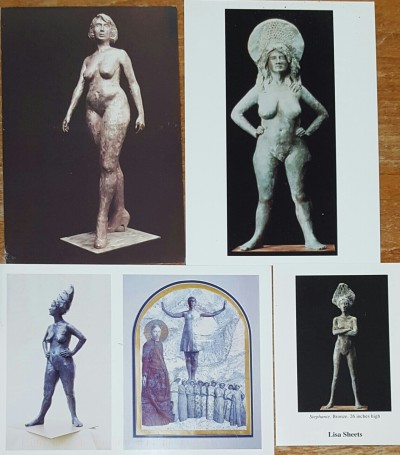
I thought of them as vaguely autobiographical even though they were usually portraits of someone else. I was showing things about how I myself and other contemporary women lived in our own skin in a modern world. After awhile I wanted to get into more different kinds of imagery. So I got a little back into printmaking and started adding mixed media. I also explored artists one of a kind books, where I was able to incorporate ‘found text’ as well.

Part of my shift to new mediums was economic because back then I was trying to “make a living as a professional artist” and it wasn’t happening. Cast metal sculpture is very expensive to make. So I struggled for many years about how to define success as an artist if you go year after year unable to make a profit or support yourself on your creative work. I’m convinced that using financial success as a marker for success, in general, is a bad idea, but in our capitalist society where we live. It’s hard to avoid that concept.
Part of the changing momentum is that an artist’s ability to support themselves with their work changes over time. Much of that is due to external obstacles or changes in the economy, political shifts, things that are outside our control. So, while we might be able to support ourselves or earn some money from art for some period of time, we can’t depend on that to last. We don’t’ get a raise or cost of living adjustment lol. So we have to be ready and creative to find ways to survive.
Janet: Once we get over that big obstacle, it’s a big moment when we still realize how much we love what we are doing and that we don’t intend to stop even if it doesn’t pay the rent or send us on fabulous vacations to Italy or the like. We get down to the business of art-making that’s free from having to support us. In Big Magic Elizabeth Gilbert talks a lot about that freedom. Not demanding our art support us. Just pouring ourselves into the creative process because it’s life-giving.
What’s been inspiring your work lately?
Lisa: What inspires my work lately is still the same thing that has always interested me. How a contemporary woman like me fits into history and what factors influence how I express myself and limit or promote who I can become. Current events are leading me, even more, to be interested in talking about how societal unwritten rules and codes and expectations of our behavior subtly lead us in certain directions or block our progress. This is in the news a lot now with the advent of everyone having cell phones with cameras. We can all see the way that people are treated differently, and expectations we have like how perfect we think we should look are built on faulty assumptions. Those models we see on TV and magazines are airbrushed! And now you can easily find a Youtube video to show you how it’s done. So I think we are in a time of shedding old limitations and ready to claim our individuality. That is the kind of thing I’m interested in showing in my work.

Janet: Yes! I see this in your work! Shedding faulty assumptions and old limitations. I’m also fascinated by unwritten rules in family structure and society. You can see this in my writing, characters like Uma in In the Time of Dragon Moon, who’s told that a woman is not allowed to be a healer, trying to shed the limitations the social demands put on her by her society. I write stories about people with the fire to break free. That’s also what I love about your work. How you mix historical images of women with modern images, and your layered use of pattern material.

Tell us when you started using sewing patterns?
Lisa: Hmmm, I think I started using patterns around the year 2000 or so. It was when I started working larger after I bought my own printing press. Before that, I was working on a small shared printing press, and the size of my work was limited to a pretty small scale. After I bought myself a large printing press, I kind of went crazy making BIG BIG work. !! and I loved the various shapes and the transparency of the pattern material. I also loved how complicated they were like an engineering schematic, even though people might disregard it as “women’s work”. I also remember when I was a child my mother was always in our family room cutting out some new pattern she was working on. She would cut them down on the floor near where we were playing, so I connect with the pattern as a remembrance of both my own childhood and also of women’s roles and appropriate outlets for their creativity.
Janet: Love this story of connection with your mom, Lisa.
Lisa: Oh, by the way, after I started using the patterns in my large work, I did discover I could find the same shapes in TINY sizes by searching for doll clothing patterns. I used a lot of those tiny pattern shapes in my artist book images.
Janet: That’s so cool! I love how you went crazy!! Then the new direction the doll patterns allowed. I’m a little jealous since the tools of my trade or paper, pencils, pens, laptops and so on. But you’d be surprised at how much writers love different kinds of pens and particular paper — and how we go nuts in stationery stores! It all comes down to loving the process, and it makes me happy to hear about your crazy fun with the large printing press. Just so happy. Stories of other artists give me Momentum!
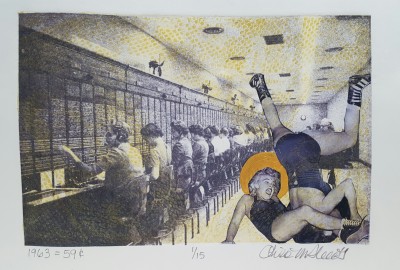
Lisa: I’m glad the story gives you happiness! That’s what I was talking about before about connecting with other creative people as a way to get support and fuel for our work. I guess what I would say in closing about changing momentums is that I have a much more flexible and broad view of my own momentum than I did 20 years ago. I no longer look to exterior sources for validation.
I have tried to create a life where my art making and my income earning are separate. That was an important step so that I am free to explore creativity the way I want, regardless of the economy, trends, or other changes in the art market. I’m not sure I have any benchmarks anymore to show me my progress. I think I have to look internally to see how I’m feeling to make the call on how I’m progressing. Oh! And we didn’t even touch on the physical changes that happen for artists as we age. I guess that is another conversation. But it is related to momentum/speed/progress also.
I guess it’s important for us to pay attention to our inner landscape FIRST and to be gentle with our changing physical needs and limitations as we age, and to never stop creating. Thanks for inviting me to this great conversation. 🙂
Janet: Thanks so much for talking with me. I learned a lot. Writing, sculpting, and collage-making are different art forms, but so much of what you said touches on my own creative process. It always has.

